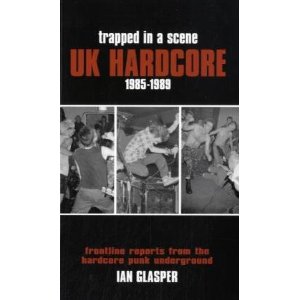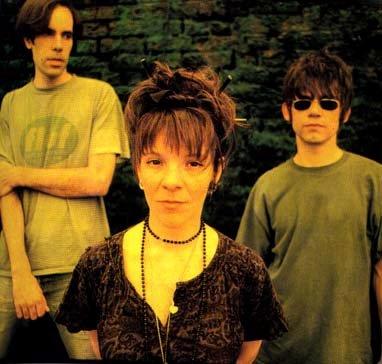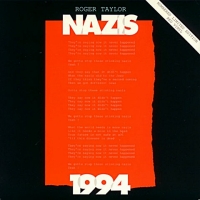These days, when punk and metal feature in the same magazines and on the same rock dancefloors, when scenes like doom metal and crust overlap so much, when a bunch of my punk friends are genuinely excited about going to the very metal Live Evil festival this weekend, and when mainstream metal has co-opted so many of hardcore's signifiers, from the breakdown to the circle pit (though rarely the politics, sadly), it doesn't seem strange that I came to punk/HC through metal. But when the likes of Kerrang! first appeared, the two genres looked scornfully upon one another. Punks thought metal was pompous, fantasy bollocks, and the metal attitude towards punk can be summed up by this eloquent chap.
Thanks, chump. Things were starting to change by the time I started paying attention in '88. The crossover between thrash metal and US hardcore had spawned a subgenre, known as, er, crossover, and so the likes of CRO-MAGS and DRI were deemed suitable fare for Kerrang!. On this side of the pond, NAPALM DEATH had kicked up such a ruckus that the bands following in their slipstream were likely to at least be mentioned in dispatches in the metal press. But overall, their coverage of punk/HC largely consisted of METALLICA's refusal to be photographed without at least one member in a MISFITS t-shirt.
However, at some point round about '89, Metal Hammer gave a teenager called James Sherry a monthly column called (if memory serves) Rotten To The Core. In what was my introduction to the DIY ethos of the hardcore scene, James would enthuse about the tapes, records and fanzines he was into, complete with prices and contact addresses. As a teenager myself (just three-and-a-bit years younger than James, I realised recently), I had very little disposable income to devote to buying music, and the generally cheap prices of these punk artefacts, along with the fact that I'd heard some of the bands mentioned on John Peel's shows, led to my making a couple of purchases which would radically redraft my musical boundaries.
The first was a tape called Fur Is For Animals. It was a benefit compilation for the animal rights group Lynx, although as they were charging less than £2 for a 34-track tape I'm not sure how much they actually raised. The music on offer included melodic female-fronted punk (JOYCE MCKINNEY EXPERIENCE ), melodic Welsh-language punk (ANHREFN), anthemic political punk (RECTIFY), US hardcore-influenced bands (INSTIGATORS, COWBOY KILLERS), gothy post-punk (TWELVE 88 CARTEL), peace punk (UPHEAVAL), thrashcore (RIPCORD, SATANIC MALFUNCTIONS), thrash metal (WAR DANCE ), metal-influenced hardcore (DECADENCE WITHIN), crusty death/grind (PROPHECY OF DOOM), anarcho punk (ACTIVE MINDS, DESIGNER FEAR), some plain weirdness (GODORRHEA), a band featuring a certain James Sherry (SCUM CHILDREN) and even more besides.
As a result of listening to this tape, my understanding of the term "hardcore" was not the standard image of the music as punk rock's harder, faster offspring, but more an umbrella term which could cover an array of bands and styles, united more by ethos than sonic similarity. (In a sense, I considered punk almost a sub-genre of hardcore, rather than the other way round). I still see the hardcore scene as something which can encompass everything from riot grrrl to power violence, emo (in its pre-MTV sense, at least) to d-beat, post-rock to metal, just so long as the people involved operate with integrity and a DIY ideology. (For any readers lost by any of the genre terminology here, my basic point is: hardcore is not just tough guys in vests trying to get you to beat each other up).
I did, however, notice something interesting when playing my Fur Is For Animals tape in the room I shared at school with four or five other kids. They literally didn't hear any of it apart from the stuff with unintelligible, guttural vocals. Never mind that the growlers were balanced in number by bands with plaintive, melodic vocal styles (itself quite a feature of the scene at that point) - the tape became synonymous with the idea that I liked ridiculously unlistenable noise, and the phrase "Fur Is For Animals", enunciated in a Cookie Monster growl, became the sort of thing my classmates would shout at me along with "Olly Thomas Is No Chicken" and "Onslaught, you Sabbat" (see earlier blogs - I'm not explaining all that again).
This general incomprehension at my latest musical discovery even extended to the two kids who had, recently, become punks... sort of. Dave Jones-Cooper and Simon Robshaw had started listening to the SEX PISTOLS, although his poshness made Jones-Cooper a pretty rubbish punk. Robshaw, however, did at least embody the part pretty well - with his skinny physique, ginger hair and slightly rodenty features, he could pull off a reasonable Johnny Rotten impersonation. While I've no idea what either of them are doing right now, the differences between them were evident when their paths diverged - while Jones-Cooper went to university, Robshaw dropped out of education before the Sixth Form and was last seen (by me, at least) in 1992 with dreadlocks and (no lie) a dog on a string, sporting the uniform of a different corner of the counter-culture.
The other significant purchase I made from James Sherry's column was the first issue of a fanzine called Everything Went Black. Published out of Belfast by a teenager called Colin Campbell, it featured interviews with the likes of NOMEANSNO, DR & THE CRIPPENS, BOLT THROWER, RECTIFY and the INSTIGATORS. While it cast more of a light into what was still quite a murky scene to me at the time, the zine itself was probably less important than the fact that Colin started tape-trading with me. The first tape I received from him featured Plastic Surgery Disasters by DEAD KENNEDYS, BLACK FLAG's Six Pack 7" and NOMEANSNO's The Day Everything Became Nothing EP, plus a tune by Colin's own band DON'T KILL SHEEP. If Fur Is For Animals was a snapshot of the contemporary UK scene, this tape was more of a US hardcore history lesson, and I loved it all. Some metal bands, particularly on the thrash side of things, wrote about socio-political issues, but never with the sarcastic, satirical approach of the DEAD KENNEDYS - and their tunes were catchy and addictive. Anyone who's remotely interested in this sort of thing knows that BLACK FLAG were just an immense force of unstoppable power. And NOMEANSNO added a surrealist bent and a curious, almost prog/funk, musical sensibility, once again reinforcing the idea that hardcore could be whatever a band wanted it to be.
Over the next few years, Colin introduced me to a slew of crucial hardcore bands, taping me more DKs and BLACK FLAG along with the likes of CIRCLE JERKS, POISON IDEA, SCREAM, JAWBREAKER, MELVINS, ALL and THE DIDJITS. He also sent some great rarities my way (an unreleased GODFLESH 12", a FUGAZI demo (still, to my mind, one of the best bands to ever walk the earth, in this or any scene) and the second demo by a then-unknown Belfast band called THERAPY?) and taped me some cult metal stuff, from MACABRE to KYUSS. The tapes fizzled out in about 1994, by which time he'd gone to university in Liverpool, probably because we forgot whose turn it was to write, although it may also have been down to him getting bored of me sending him indie and thrash metal stuff that he wasn't into (although I recall he quite liked the end of I Am The Resurrection by THE STONE ROSES).
So I guess the reason punk and hardcore haven't been mentioned too much in previous chapters of this blog is that I didn't get to any shows for a while. Clearly, none of my school friends were interested, and I wasn't aware of any DIY shows going on in Somerset. Instead, I continued to buy demos, compilation tapes and fanzines, while ordering vinyl from Full Circle, a distro run by Andy Turner from the INSTIGATORS (these days to be found doing press for metal labels). Another significant purchase was made after (ironically) a house party at Simon Robshaw's; when my Mum picked me up, ashen-faced, the following morning, we drove home via Taunton and I bought Peruvian Vacation by THE STUPIDS from Our Price. Not the best cure for a fifteen-year old's first proper hangover, but a great rekkid nonetheless, and it took my mind off the fact that I'd spent three or four minutes of the previous evening attempting to seduce a girl by slow-dancing with her to Carrie by EUROPE.
When I went to Southampton Uni in '93, I was finally in a town with a punk scene, but it still took me a year to make it to a show, even though some of my new friends were into punk - Jason wore a BAD RELIGION shirt and Anneka even introduced me to Wedge from RECTIFY, who I'd written to a couple of years earlier, at an alternative club. He was drunk.
It appeared that all the punk gigs at The Joiners were promoted by someone - or something - called the STE Collective. This shadowy organization, it seemed to me, would almost certainly be a bunch of hardline anarchists ready to judge anyone with the wrong attitude/accent/clothes/haircut, and I didn't feel confident enough to put myself in a situation where my punk credentials would be found wanting. As a consequence, I missed shows by THE JOYCE MCKINNEY EXPERIENCE, SHUTDOWN, EXIT CONDITION, FABRIC, WORDBUG, RHYTHM COLLISION, HERB GARDEN, MTA, RAN, HOOTON 3 CAR, OI POLLOI, UNWOUND and the obligatory "many more".
SONIC YOUTH made a movie called "1991 - The Year Punk Broke", about the success of NIRVANA and the elevation of underground bands to mainstream attention. But while NIRVANA had roots in punk (most obviously Dave Grohl's time as a member of SCREAM), the real Year Punk Broke was 1994. GREEN DAY (who'd played an STE show at The Joiners in 1991) and OFFSPRING took pop punk into the worldwide charts, Southampton's rock DJs started playing BAD RELIGION, NOFX (another band with STE shows under their studded belts) and RANCID, and I realised that maybe now I could convince my housemates to come down to a punk rock show.
That show was JAWBREAKER, on November 1st 1994. I told Alex, Lucy and Gail that they sounded a bit like the BAD RELIGION and GREEN DAY tunes they were digging on the Nexus dancefloor, which was maybe stretching things a bit, but it got them down to the show with me. I was used by now, through the reviews I'd written for Kavort and Wessex News, to getting into the Joiners for free, but as a non-profit entity, the STE weren't down with the concept of a guestlist, making for a slightly awkward conversation on the door.
It turned out that the STE Collective weren't a bunch of intimidating scene police after all. Their key members at this point were Rich Levene, an unassuming looking chap who didn't dress remotely "punk" but lived and breathed this music (essentially the exact opposite of a Simon Robshaw punk), Rob Callen, a bespectacled fellow with frizzy hair, and PJ, who looked a little bit like a dreadlocked Captain Pugwash. They promoted their shows with a monthly bulletin, consisting of a sheet of A4 folded three times to produce a six page pamphlet. Aside from the bulletin number and date, the cover of each edition was identical, with the STE logo (featuring a drawing of a hardcore singer mid-leap) and the slogan "START A BAND!... WRITE A FANZINE!... PUT ON A GIG!... IF WE CAN DO IT, ANY ONE CAN!!" Inspiring stuff, and for once I'm not being sarcastic. Inside the bulletin you'd find columns by STE members and various other contributors, news on local bands and shows, previews of forthcoming STE activity, contact details for local bands, promoters and zines, a grainy photo of an STE regular and, always, an introductory paragraph about the STE, its history ("all of us have been active in the punk/hardcore scene since the early 80's (e.g. South Hants Fanzine Collective, NOX MORTIS/SUICIDE PACT, 'Bouquet' 'zine etc)") and its values ("those time-honoured principles of trust, honesty + a sense of community spirit"). (All usage of Caps Lock, underlining and bold print reproduced as seen in the bulletin - the band names throughout this blog have been similarly treated in tribute to STE style). It also explained that STE didn't stand for "Smash The Empire" or something like that but, rather more prosaically, for "Southampton, Totton and Eastleigh", the three towns from which its members hailed.
Anyway, back to the JAWBREAKER show. PJ was on the door, and I don't recall who backed down about my getting in for free, but I do remember writing to the STE address the next day to apologise and suggest that they probably hated me anyway as both a student and a journalist. I got a reply in due course from Rich Levene, who took my ridiculous paranoia (and stereotypical idea of what punks did and didn't like) in good humour, explaining that the STE's members had been students and had dabbled in journalism themselves. He also said I should say hello next time I went to one of their shows. What a good bloke.
The support band that night was a bunch of locals called THIRST!. As a newcomer to the local scene, I didn't know that their guitarist Steve Burgess had passed away a few months earlier, so my review in Wessex News merely complimented them on their melodic hardcore sound instead of dwelling on recent tragedies. You can check out their recorded work on the Suspect Device website by following this link...
http://web.mac.com/tonysuspect/Suspect_Device/SD_releases.html
JAWBREAKER were a pretty big deal at the time of this show, with the STE bulletin even implying that their appearance at the Joiners would go down in history alongside the aforementioned GREEN DAY and NOFX gigs. At this point, they'd recently released their third album, 24 Hour Revenge Therapy, still considered their best by the cognoscenti, and their tuneful and emotional punk rock made my first proper hardcore show one to remember. Alex, Lucy and Gail weren't overly keen, though.
Here's some footage of Jawbreaker in Leeds from the same tour.
I carried on going to STE shows for the rest of my time in Southampton, and became friends with Rich and Rob (though I never got beyond nodding terms with PJ - perhaps he always saw me as that student journalist wanker who tried to blag in free to a non-profit show). I also got to know a bunch of the regulars: Rooster, thus named (I always assumed) because of his spiky hair, which made him the only STE gig-goer you'd confidently select as a punk in an identity parade; Cov John, a boisterous fellow; Tony Suspect, the man behind the mighty Suspect Device zine; Jon Fry, who was the singer in THIRST! and the STE regular most likely to be found in Southampton's alternative clubs for a boozy chat; members of local punk bands like SMOG UK and HAYWIRE, about whom you'll be hearing more in future blogs; and plenty more over the years, especially when the STE had a sudden influx of new faces which gave the whole scene a new lease of life (and a bunch of new bands) at the end of the 90s. I ended up contributing to the bulletin on occasion, and played STE shows with three different bands, one just a week before I moved away from Southampton in 2003.
The STE Collective doesn't really exist these days, although Rich still puts on all-dayers once or twice a year in Southampton. But over fifteen years and more than 200 shows, they created something which I still hold up as a sort of ideal, both in terms of the way they conducted themselves and their selection of generally shit-hot bands; gushing though this might appear, I genuinely view the STE in the same sort of light as John Peel and precious few others.
Punk rock continues to inspire and inform me, and there will be plenty more occasions to sing its praises as this blog continues to slowly dredge the 90s and beyond. Anyone interested in some serious nostalgia is directed to Ian Glasper's excellent trilogy of books covering the UK punk scene from 1980-1989, with Trapped In A Scene particularly relevant to the bands featured on Fur Is For Animals.



















